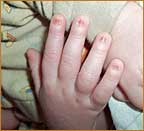General symptoms of EDS
Because of the extent of issues, which can range from mild to more complex, a team of professionals (multi-disciplinary) approach is usually required. Affected individuals may work with specialists in dentistry, dermatology, asthma / allergies, genetics and ophthalmology to ensure they receive the care required. Health care and funding is provincially mandated in Canada and there are programs available to help offset some of the costs associated with medical needs for those with EDS.
Hair
Hair can be sparse on the scalp and body. It is usually light in colour, brittle, and slow to grow. It may be very fragile, curly, twisted and hard to manage. Body hair at puberty and beard growth in males may not be affected. Eyebrows and eyelashes can be sparse or missing.
Nails
 Fingernails and toenails may be thickened, abnormally shaped, discoloured, ridged, slow to grow and/or brittle. Cuticles may be prone to infection.
Fingernails and toenails may be thickened, abnormally shaped, discoloured, ridged, slow to grow and/or brittle. Cuticles may be prone to infection.
Skin and Sweat Glands
With some ED syndromes, the affected person can not perspire or perspiration is limited as sweat glands may not developed completely or at all. Without normal sweat production, the body can not regulate temperature properly, therefore overheating is a serious problem. Hot weather, illness causing fever, exercise and activity can all cause body temperatures to rise so access to cool environments and fever-reducing medicines is important. For many ED syndromes, skin is lightly pigmented, is prone to rashes, eczema, and/or infections, and skin over the palms and soles may be thickened. Thus it is important to treat the skin to avoid infection, cracking and bleeding.
Teeth
It is through the development of the teeth, or lack thereof, that is often the first indicator to a health care professional (most often the family dentist), parent or caregiver that something is wrong, eventually leading to the diagnosis of an ectodermal dsyplasia syndrome. Because the development of tooth buds is impacted, teeth can be missing (hypodontia), or malformed (peg-shaped or pointed) and are slow to grow. Dental treatment for cosmetic purposes is available, and even young children can be fit for dentures which can be replaced as the child grows. Once a child stops growing (usually around age 18), dental implants also may become an option. Teeth can also be crowned. Lack of salvia can make teeth more prone to decay and poorly formed enamel means tooth care is very important.
Eyes
Like so many of the health issues that accompany a diagnosis of ectodermal dysplasia, the severity and ways the eyes are impacted are numerous. Many of the eye issues are caused by tears – or more specifically, the lack of tears which means individuals are more prone to eye infections, corneal problems and cataracts – along with light sensitivity. Missing eyelashes, also a common component of many ectodermal dysplasia syndromes, means more dust and dirt can get into the eye – and without tears or fluid to wash it away, again can lead to infections and damage to the eyes. Tear supplements like simple saline drops or lubricant for dry eyes do help but tears also have many other natural chemicals so these products can’t replace the positive function real tears have on the eye and the eye surface.
The University of Liverpool Ophthalmology Research Unit has an excellent online article called Eye Problems and Ectodermal Dysplasia which can be found by clicking here (http://www.liv.ac.uk/). Thank you to the Sprung family for sending us this resource.
Other Symptoms
Some EDS symptoms can include cleft-lip or palate, deformation of the hands or feet (including clefting or missing digits), hearing or vision deficiencies, nutritional needs, respiratory problems, dry nose, reduced tear duct functionality, light sensitive and/or dry reddened eyes.
Physical Appearance
People with an ectodermal dysplasia syndrome may have distinctive cranial-facial features including cupped ears, saddle nose (flattened bridge), predominant forehead, small nostrils, lack of frenulum (under the tongue), or a broader nose.